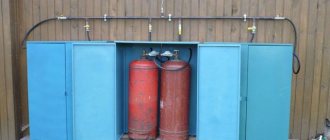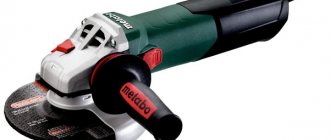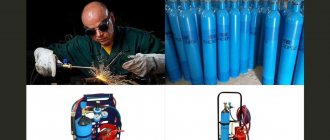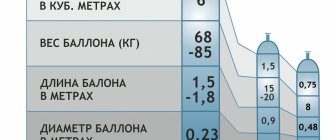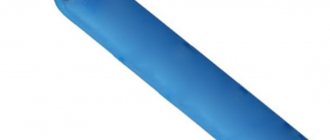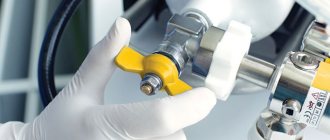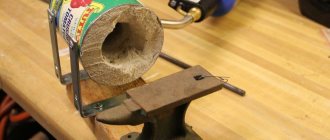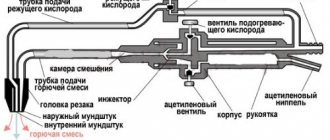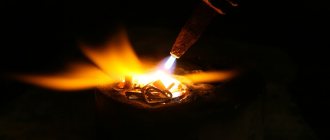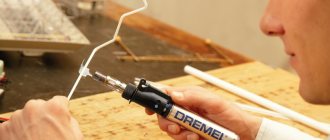How to cut a balloon safely
When making a gas cylinder from propane or other gas, fairly high quality metal is often used. That is why many are considering the possibility of cutting it to obtain blanks, which are later used to create various products. When considering how to cut a gas cylinder, it is recommended to pay attention to the following points:
- The body can be a good workpiece for making a stove, water tank or barbecue.
- Before actual work, the oxygen gas cylinder should be emptied, since the gas at its high concentration is not only flammable, but also explosive. Therefore, before cutting, you should check the filling level of the gas cylinder.
- As a rule, there are no significant problems with oxygen and carbon dioxide gas cylinders. This is due to the fact that ordinary iron is used in their manufacture.
- Propane gas tanks can cause some pretty serious problems. This is due to the fact that it is quite difficult to empty them completely; this requires preliminary preparation.
Gas cylinder explosion
Before you begin, you also need to prepare the required set of tools. As a rule, it can be found in almost any garage and workshop.
Types and design of valves
The threads of valves for gas cylinders are standardized, but they themselves can have a variety of designs. The choice of valve model is influenced by the type of chemical substance being stored, production features of operation and the amount of money. Before purchasing new equipment, you should familiarize yourself with the design options and internal structure of the valves.
Classification of shut-off valves for cylinders
The design features of gas cylinder valves are determined not by the whims of engineers, but by safety considerations.
Gas valve model VB-2. This valve model has proven itself positively back in Soviet times. It has been used in everyday life and industry for decades, causing a minimum of problems.
Depending on the material used, shut-off valves are divided into:
- brass;
- steel.
The choice of metal for the manufacture of the valve body is determined by the type of gases contained in the cylinder. There are the following types of shut-off valves, depending on the type of chemicals stored:
- Acetylene. The body of such cylinders is painted white. Special valves are used in cylinders containing acetylene, chlorine, ammonia and other aggressive substances.
- Oxygen. The cylinders are painted blue and are intended for storing oxygen, argon, hydrogen, nitrogen, carbon dioxide and other inert gases.
- Propane-butane. They are painted red and are intended for storing substances corresponding to the name and other gaseous hydrocarbons. The most common valve type model for such a cylinder is VB-2.
Valves for acetylene cylinders are not made of brass because the substances they contain may react chemically with copper. Typically, carbon or alloy steel is used to manufacture shut-off valves of this type.
Gas valve device
A standard gas valve has the form of a tee, each fitting of which has an external thread. More advanced models may have an additional protrusion - a safety valve. Its purpose is to relieve excess pressure in the event of a full cylinder heating up or in case of incorrect filling.
The lower fitting of the valve is used to connect to the gas cylinder, the upper one is used to attach the flywheel, and the side one is used to connect communications for gas outlet and injection. The valve design for a gas cylinder is quite simple. Shut-off valves usually consist of the following general elements:
- Brass or steel body.
- A stuffing box valve or flywheel connected to the body with a union nut.
- Internal locking mechanism with valve and stem.
- Sealing gaskets.
- Plug for the outlet.
You can look at the design of valves on gas cylinders of each type in more detail in the presented images.
Image gallery Photo from The release of poisonous gases through a safety valve can be harmful to health even in an open space
Acetylene valves use maximum seals to prevent toxic gases from getting out.
The gaskets in such a valve should not be made of pure rubber, because it can interact with oxygen
The seals on propane cylinders are simple, so they must withstand a maximum pressure of only 16 atmospheres
Valve with safety valve
Valve for acetylene cylinder
Valve for oxygen cylinder
Valve for propane-butane cylinder
Worn valves can leak small amounts of gas, which can lead to unpredictable consequences in enclosed spaces. To prevent such situations, a plug is used on the side fitting, which serves for additional sealing of the cylinder during transportation and long-term storage.
The direction of the threads on the outlet holes depends on the chemicals contained in the cylinders: the right is used for non-flammable gases (oxygen, nitrogen, argon, etc.), and the left is used for flammable gases (hydrogen, acetylene, propane, etc.)
The principle of operation of the assembled gas valve is unremarkable. To supply gas and shut it off, simply slowly turn the flywheel in the appropriate direction.
What will you need?
To carry out the work in question, a certain set of tools is required. As a rule, cutting is carried out with a grinder. Other necessary tools are as follows:
- Gas and open-end wrench for working with the valve. In order to remove all the gas from the container, the valve must be fully opened.
- A hacksaw is also used for cutting, for example, in the case of cutting off the neck. It is worth paying attention to the correct choice of a suitable cutting blade, since too soft metal leads to rapid grinding of the teeth.
- Water is used to clean the surface. It is usually poured into a container.
When working with an angle grinder, you should be careful, since the circle is in contact with a small area. In addition, when cutting, you should use safety glasses, as a large number of fragments and burning abrasive are formed.
Cutting a gas cylinder with a grinder
For an angle grinder, it is important to choose the most suitable circle. This is because the wrong abrasive wheel can quickly wear down. Before each cutting, you should check the integrity of the nozzle and its secure fastening. Cutting without a protective cover is not allowed.
How and what to paint
Paint selection
It is best to paint the grill with heat-resistant paints, because when cooking in it the temperature can reach up to 700 degrees. When choosing paint, this is the first thing you should pay attention to. Usually the instructions for the paint indicate the temperature it can withstand.
In addition, it is important that the paint, when heated, does not release harmful substances to the human body.
Painting stages
- Clean the body of old paint using a drill and a special metal attachment or sandpaper.
- Degrease the surface with alcohol, acetone or solvent.
- Mix the paint well to obtain a uniform consistency and remove any sediment or clots. If the paint is too thick, thin it with thinner.
- Apply paint using a brush or roller. It is better to use several layers to get a beautiful and smooth surface. Each layer must be dried for 30-120 minutes depending on the type of paint used.
Please note that it is necessary to paint the grill outdoors at an air temperature of no lower than 20 degrees and no higher than 40, because at lower temperatures the paint will freeze, and at higher temperatures it will bake.
( 1 rating, average 4 out of 5 )
How to proceed?
Once everything you need has been purchased or found, you can begin the actual work. The sequence of actions is usually as follows:
- The valve opens fully to completely release the gas. Do not forget that even a small amount of such a substance can lead to fire or explosion. In addition, all clothes can become saturated with harmful odors. You can make sure that there is no more gas left in the container by covering the valve with a soapy mixture. You can drain the remaining gasoline only after completely unscrewing the valve and removing it, which is not recommended if there is pressure.
- The next step is to unscrew the valve, after which the pins and the fixing element are removed. Removing this locking mechanism is quite difficult in some cases, but if possible, a diameter of 6 mm is formed. If you can’t unscrew the valve, you can cut it off using a regular hacksaw. You can reduce the likelihood of fire by supplying water to the cutting zone, for which it is enough to use a regular hose.
- After this, the gas tank is filled with water. This is required in order to remove any remaining gas that may remain in the semi-closed container. The resulting gasoline solution can be safely drained, as it is absolutely safe and cannot ignite.
- It is worth considering that the resulting liquid has a persistent and rather pungent odor. That is why it is recommended to drain it away from the structure. To speed up the process, you can supply compressed air to the gas container.
- After the container is completely cleaned, you can begin actual cutting. To do this, mark the surface, for which you can use chalk. Many people cut along welded seams, since they are characterized by less high strength.
- Before work, it should be taken into account that in most cases, steel with a thickness of 3-4 mm is used in the manufacture of a gas cylinder. At the joints this figure increases to 5-6 mm. Almost any grinder can cope with such a task.
- You can simplify your task by passing the grinder prematurely when using a 1.6 mm thick disc. By using a wider blade, you can eliminate the possibility of jamming the attachment that will be used for the final cutting.
- Some thicker elements may be cut, and then cut with a chisel and hammer. Due to this, the cutting process is accelerated, but the quality of the resulting cut is significantly reduced.
The cutting methods under consideration are used so that the gas cylinder can be reused in the production of a wide variety of products. If, after cutting it, a pungent odor remains, then the inner surface is burned with a blowtorch. After such processing, the body will be ready for further use.
Preparing the barbecue cylinder for cutting
Before you make the first cut, you need to protect yourself. To do this, you need to fill the bottle with water. How it's done? Before you start working, you need to make sure that the cylinder is empty. To do this, open the shut-off valve, which is located in the upper part of the cylinder and determine by ear whether there is any hissing of gas. Next, in the same way, with the tap open, turn it down so that all the available liquid flows out from the inside.
The stopcock is made of bronze alloy, and bronze is a very soft metal to work with. Therefore, we take a hand hacksaw for metal and at the bottom of the tap, where it screws into the cylinder, we cut off the tap completely. We now have an inlet hole into which we can insert a watering can or hose to fill it with water. You need to understand that the water that will fill the cylinder will displace air saturated with gasoline, therefore it is prohibited to smoke or use open or hidden fire during this operation.
The container must be completely filled with water. After this we make a cork. A cork stopper from a wine bottle or something like that can help us here. Having trimmed it a little, we hammer it tightly into the hole with a hammer. Then we place the balloon in a horizontal position and make a cut.
What should you pay attention to?
There are a few things to consider when cutting. The main ones can be called:
- Cutting must be carried out using special protection.
- Processing along the seams is easier, but often the markings do not match. When cutting on a round plane, you need to put a slight load on the grinder, since a small contact area leads to slipping of the nozzle.
- Many problems arise with removing rust and paint.
In general, we can say that the cutting process does not create significant problems.
Semi-automatic welding: what happens and how
If with welding with electrodes everything is more or less clear: you inserted the electrode into the holder, threw the mass onto the workpiece and began to cook, but with semi-automatic welding, things are different. When semi-automatic welding, a wire is used as a filler material, which is enveloped in shielding gas during welding.
In turn, gas is needed to protect the weld pool from its interaction with the environment. This is the main disadvantage of semi-automatic welding, since you need shielding gas, which is not always at hand.
What to do in this case? Is it possible to cook with wire and semi-automatically without gas?
Examples of using cut gas cylinders
The parts of the cylinder can be used to achieve a variety of purposes. The following cases are examples:
- Furnace body.
- Containers for storing liquids.
- Grill.
- Smokehouse.
Gas cylinder stove
The scope of application is wide, but it is worth considering that the metal is not characterized by high corrosion resistance. An exception is a propane gas cylinder, which is coated with paint using a special technology.
At home
The rules for the use of gas cylinders, as well as their manufacture and storage, are set out in several official documents:
- “Industrial safety rules for hazardous industries where equipment under excess pressure is used,” approved by Order No. 116 of March 25. 2014 Federal Service of Rostekhnadzor.
- PPR in the Russian Federation.
- GOST 15860-84, establishing technical. conditions for cylinders with liquefied hydrocarbons with pressure up to 1.6 MPa.
The recommendations of the Federal State Institution VNIIPO dated June 13, 2000 on the tactics of fire departments in conditions of the possibility of an explosion of gas-cylinder equipment at the source of a fire provide the following information:
- Cylinders for storing and transporting liquefied/compressed hydrocarbon gases (LPG) have become widespread in various areas of industry, as well as in everyday life.
- In accordance with GOST 15860, 25 enterprises in Russia produce welded steel cylinders for storing LPG.
- Their total number is about 40 million pieces.
- The main types have a capacity of 27.50 liters, which is up to 85% of the total.
Storage and use of gas cylinders
Considering that, according to GOST, the permissible service life of cylinders subject to compliance with the rules, technical inspection once every five years is 40 years, it is easy to imagine that in recent years their number has increased both in everyday life for cooking, on construction sites, in the workshops of industrial enterprises for fire , including gas welding work, has only increased; as well as the number of fires, where explosions took place, and loss of life.
Basic requirements of industrial safety standards for the use of cylinders with propane, butane, and their mixture when used in everyday life:
- It is prohibited to store LPG cylinders in private houses, apartments, stairwells, basements/attics, and on loggias/balconies of multi-story residential buildings.
- Kitchen stoves and gas units for heating water are required to have an LPG supply from tanks installed outside residential buildings in extensions/cabinets made of non-combustible material, located near blank external walls, at least 5 m from the entrances to the house, basements/basements. An exception is 1 tank up to 5 liters connected to the stove.
- Cabinets for containers with LPG must be locked, equipped with blinds for constant ventilation, and provided with the following inscriptions: “Flammable. Gas".
- At the entrances to private houses, townhouses, block sections, premises of buildings where LPG tanks are used, an inscription/plate is placed: “Flammable. Gas cylinders."
The simplest precautions are also mentioned - it is forbidden to use household appliances if there is a gas leak that has a characteristic odor; Under no circumstances should you check the tightness of any connections in the gas path from the entrance to the apartment to the devices using an open flame. At home, you can check for gas leaks with a soap solution, but it is better not to do it on your own; and shut off the supply and, depending on the situation, call representatives of the emergency gas service or service organization/enterprise
At home, you can check for gas leaks with a soap solution, but it is better not to do it on your own; and shut off the supply and, depending on the situation, call representatives of the emergency gas service or service organization/enterprise.
Rules for storing gas cylinders
Rules to follow when cutting
The rules for using an angle grinder in this case are not much different from those for other work. The main ones can be called:
- Work must be carried out in special clothing, which is made of non-flammable material. Do not work with exposed areas of skin, as contact with fragments may cause a burn.
- Before cutting, you should pay attention to the condition of the disk: the degree of wear, the presence or absence of defects, and much more.
- Cutting should only be done with safety glasses. When cutting, a fairly large number of fragments are formed, which can get into the eyes and cause injury.
- The grinder should only be used with a protective cover.
- When working metal, it is recommended to stand to the side of the cutting line.
- In some cases, cutting is divided into several stages. When cutting for a long time, the accessory used may cause it to become hot. Too high a temperature increases the wear rate.
In addition, cutting should be carried out only when the gas container is completely emptied. This is due to the fact that even a small amount of gas can lead to detonation.
When cutting, a large number of fragments are formed, which will immediately ignite the flammable mixture.
Safety rules when working with an angle grinder
When cutting metal, it is important to take into account the basic rules for using an angle grinder, which allow the master to create the safest conditions possible while working.
The features of working with an angle grinder include the following rules:
- Before starting to work with an angle grinder, you must wear a special protective suit made of non-flammable material. It is not recommended to cut metal while wearing clothing with exposed skin, since if fragments get on its surface, a burn may form.
- Before you start cutting metal, you should pay special attention to the condition of the disc. It is recommended to inspect the nozzle for defects and assess the degree of wear.
- Metal cutting is carried out only with safety glasses, since during the work a huge number of fragments are formed that fly in different directions and can cause serious injury to the eyes.
In some cases, the steel cutting procedure is divided into several stages. This is necessary when the nozzle heats up during long-term cutting, which causes it to wear out quickly.
In addition, prolonged use of the grinder often leads to malfunctions in its operation, which can even lead to injury to the technician.
Professional craftsmen recommend using a respirator when working with an angle grinder, since when cutting steel, microscopic fragments of metal can be released into the air and settle in the human respiratory tract.
Which is better
The most preferred ones in everyday life are composite (polymer) containers. The advantages in reliability, compactness and other indicators make them obvious leaders compared to their metal counterparts.
The only disadvantage of a polymer tank is its smaller maximum volume.
If for a metal cylinder this figure is 50 liters, then for a composite cylinder it is 33.5 liters.
That is, it is advisable to purchase a metal tank only in cases where high gas consumption is expected, since the need for refilling will arise less often.
The volume, connection method and other parameters must be selected individually, in accordance with the needs of the buyer.
If you need a supply of fuel for portable, including travel, gas equipment, then you need to choose a product among compact disposable cartridges with the appropriate type of connection.
The choice also depends on the temperature at which the gas equipment will be used. The type of mixture is indicated on the container - winter, summer or all-season.
Brazier made from a pipe and with a pipe
Building a brazier from a pipe is a little more difficult. In the sense that you will need to weld the ends. All other operations are no different. Even the designs are exactly the same.
Barbecues made from pipes - manufacturing will require a little more time: you need to weld the sides
But using a pipe has its advantages: since we’re going to weld the sides anyway, why not make a door (pictured on the left). You can use an old one from the stove - you can put firewood through it, and also regulate the air supply while the coals are “cooking”.
Brazier with pipe
To ensure better draft and so that smoke does not disturb those nearby, you can attach a smoke exhaust pipe to the side of the barbecue from a cylinder, pipe or barrel. This will add more work, but not very much. But it will be more comfortable to use: the smoke is good on a barbecue, but you don’t want to breathe it at all.
Barbecues with a pipe are more comfortable - the smoke goes up. You can also arrange everything in different ways.
Read about how to make a simple brick grill here.
Malfunctions and repairs
Warranty and post-warranty repairs of a gas cylinder must be carried out by a qualified specialist.
Attempts to troubleshoot problems yourself lead to tragic consequences.
Reasons why a gas tank is found unsuitable for use during an ongoing inspection and is sent for repair:
- malfunction of the valve, pressure gauge (including cracks in the glass that prevent readings from being taken);
- damage, displacement or missing shoe;
- wear or malfunction of the thread of the neck ring;
- violation of tightness, leakage;
- for metal containers, color discrepancy or discoloration.
The gas storage tank must be disposed of and not repaired if the following deficiencies are detected:
- significant external damage: corrosion, dents, bulges, fistulas, cracks, risks, more than 10% of the container wall thickness;
- absence of passport data, markings in whole or in part (if, based on residual information, it is not possible to restore the marking);
- cracks on and around the weld more than 0.2 mm wide and more than 30% of its length.
All other containers after warranty or post-warranty repairs are suitable for further use.
Oxygen cylinders
Figure 2 - Acetylene cylinder
Maximum pressure of acetylene in the cylinder
is 3 MPa. The pressure of acetylene in a fully filled cylinder changes with temperature:
The pressure of filled cylinders should not exceed
at 20°C 1.9 MPa.
When the valve of the cylinder is opened, acetylene is released from the acetone and enters in the form of a gas through the reducer and hose into the burner or cutter. Acetone remains in the pores of the porous mass and dissolves new portions of acetylene during subsequent fillings of the cylinder with gas. To reduce acetone losses during operation, it is necessary to keep acetylene cylinders in a vertical position. At normal atmospheric pressure and 20°C, 28 kg (l) of acetylene are dissolved in 1 kg (l) of acetone. The solubility of acetylene in acetone increases approximately in direct proportion with increasing pressure and decreases with decreasing temperature.
To fully utilize the cylinder capacity, it is recommended to store empty acetylene cylinders in a horizontal position
, as this promotes uniform distribution of acetone throughout the entire volume, and with tightly closed valves. When acetylene is removed from the cylinder, it carries away some of the acetone in the form of vapor. This reduces the amount of acetylene in the cylinder during subsequent fillings. To reduce the loss of acetone from the cylinder, acetylene must be withdrawn at a rate of no more than 1700 dm 3 /h.
To determine the amount of acetylene
the cylinder is weighed before and after filling with gas and the amount of acetylene in the cylinder in kg is determined from the difference.
Weight of empty acetylene cylinder
consists of the mass of the cylinder itself, the porous mass and acetone. When taking acetylene from a cylinder, 30-40 g of acetone per 1 m 3 of acetylene is consumed along with the gas. When removing acetylene from a cylinder, it is necessary to ensure that the residual pressure in the cylinder is at least 0.05-0.1 MPa.
Use of acetylene cylinders
instead of acetylene generators,
it provides a number of advantages
: compactness and ease of maintenance of the welding installation, safety and improved working conditions, increased productivity of gas welders. In addition, dissolved acetylene contains fewer impurities than acetylene obtained from acetylene generators.
The reasons for the explosion of acetylene cylinders can be sudden shocks and impacts, strong heating (over 40°C).
Cylinders for propane-butane are produced
according to -84 welded from sheet carbon steel.
The main application was found in cylinders with a capacity of 40 and 50 dm 3. Propane-butane cylinders are painted
red with the word “propane” written in white.
The propane-butane cylinder is
a cylindrical vessel 1, to the top of which the neck 5 is welded, and to the bottom - the bottom 2 and the shoe 3. A brass valve 6 is screwed into the neck. Backing rings 4 are pressed onto the cylinder body. A cap 7 is used to protect the cylinder valve.
The cylinders are designed for a maximum pressure of 1.6 MPa. Due to the high coefficient of volumetric expansion, cylinders for liquefied gases are filled to 85-90% of the total volume. Cylinder filling rate
for propane - 0.425 kg of liquefied gas per 1 dm3 of cylinder capacity. 24 kg of liquid propane-butane is poured into a cylinder with a capacity of 55 dm3. The maximum gas extraction should not exceed 1.25 m 3 /h.
